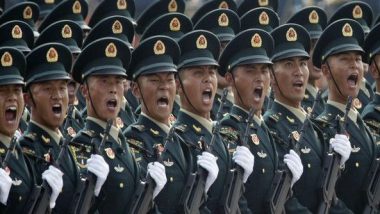Hong Kong, October 16: China is implementing the largest military build-up the world has seen since the end of World War II. The uppermost question that needs to be answered is why. China has been investing heavily in the People's Liberation Army (PLA) even though the country is not at war and despite the fact that no country is directly threatening or targeting the authoritarian nation. People's Republic of China 70th Anniversary: President Xi Jinping to Preside Over Annual Military Parade, Know Importance & History of China's National Day.
Nonetheless, Chairman Xi Jinping has prioritized modernization of the PLA.Who is the primary target in China's military sights? That is the question ANI asked Andrei Chang, founder of KanwaAsian Defence. There was no doubt in the editor's view: "Taiwan is number one."
While Xi has been busy militarizing the South China Sea via a chain of reclaimed reefs that now host runways, ship berths, and military facilities, Taiwan remains the strategic priority for China.
Chang elaborated: "The South China Sea is already done in the first stage because they built many, maybe three, artificial military bases, including airports. If there's a possibility of trouble with the USA, America may invade such ocean islands and isolate them. In the case of a small-scale confrontation occurring, this is what will happen in the South China Sea. But the main, main target, the first priority, is Taiwan.
"The Canadian resident, who has studied the PLA for decades, said that Xi wants to not only learn from Mao Zedong but to actually go beyond what Mao achieved because Xi "is a very ambitious guy". "He really wants to do some big thing, according to my information. He always talks to high-ranking military commanders, and it's this generation's mission to achieve unification. I do think the most dangerous area in Taiwan, and that's why many things in the military parade focused on Taiwan.
"Chang was referring to the massive parade on 1 October when the PLA showed a plethora of new hi-tech weapons, of which 40 per cent had never been shown to the public before. Indeed, that parade demonstrated just how much research and development, as well as investment, is being poured into the PLA, the armed wing of the Communist Party of China. With so much new shiny equipment in its hands, is the PLA willing to use it forcefully at the behest of its communist leaders? Would China actually be willing to attack Taiwan?Chang gave his opinion.
"Yes, it's very possible. Otherwise, why have they invested so much? At the moment, however, I think the first priority is economic and political warfare. They've penetrated Taiwanese society so much, including the press and media to make them more pro-Chinese. It's psychological warfare and propaganda warfare at the moment, as well as economic warfare against Taiwan. But if nothing works, Xi Jinping might think of the military struggle. He always uses the phrase 'military struggle preparation' or 'military struggle combat readiness'. He's serious and he could do anything within his term. China Reconfiguring its Military as it Increases Size of its Airforce and Navy.
"Given that Xi has already changed long-held rules -abrogating a regulation requiring the general secretary of the party to retire after two five-year terms - that means Xi has plenty of time to bring Taiwan to heel and to consider military options if current methods continue to fail.
Of course, the complicated and increasingly violent mess that has enshrouded Hong Kong for the past few months - a territory that is normally pragmatic and mostly concerned with making money - is demonstrating to all in Taiwan the dangers of embracing China. Indeed, the way Xi has handled Hong Kong is irreversibly repelling many Taiwanese.What is more, China has modernized its military while the world's preeminent superpower - the USA - has been otherwise engaged in operations in places like Afghanistan, Iraq, and Syria. Belatedly, the USA is reacting to this surge in Chinese military capability, which now enjoys superiority in some technological areas.
The semi-panic that the US military and its political overlords are suddenly experiencing after neglecting the Asia-Pacific region for so long is becoming evident. An example is the formal guidance that General David Berger, Commandant of the US Marine Corps (USMC), recently published. He declared the corps would now focus on Asia-Pacific and that China specifically was a "long-term threat".
In other words, he recognized it is time for the USMC to gird its loins against the PLA. Referring to all US forces in the Pacific, the USMC commandant wrote: "...Our (forward-deployed) forces currently lack the requisite capabilities to deter our adversaries and persist in a contested space to facilitate sea denial." This is a serious admission, acknowledging that the Chinese might win a shoot-up, and certainly that the PLA has got the jump on the US Marines.
While the USA was preoccupied with fighting insurgencies in the Middle East, China became a peer competitor. Retired US Navy Captain Jim Fanell, the former head of navy intelligence in the Pacific and who was fired for voicing concerns about the rise of the PLA because it was politically unpalatable, noted: "...When it comes to war at sea, they [the PLA Navy] are today the superior competitor.
"Indeed, China has an arsenal of ballistic and cruise missiles, as well as anti-ship missiles that easily outrange those on USN warships, plus its cyber and space capabilities threaten American command-and-control systems.A source, a former middle-ranking officer in the USMC with many years of experience in Asia, told ANI: "US Marine Pacific commanders would go to Washington, and return shaking their heads that nobody at Headquarters Marine Corps was interested in the Asia-Pacific, much less the China threat.
Even the Pacific Command was often in appeasement mode. Only the Middle East 'sandbox' mattered, while willy-nilly engagement went on with China to show Beijing that we meant no harm."Belatedly, the USA is now beginning to adjust its military strategy in response to China. Beijing developed its own anti-access area denial (A2/AD) strategy whereby it aims to keep the US military at arm's length from China's coast. Yet such an A2/AD strategy works both ways.
The American source thus told ANI, "The Asia-Pacific has many islands and archipelagos with narrow confined seas. So marines occupying or seizing key terrain and using their own anti-ship missiles, long-range rockets, air defense weapons, smart sea mines and suchlike can just as easily turn Asian island chains and nearby seas into no-go zones for Chinese ships and aircraft trying to break out into the Pacific Ocean.
"The former USMC officer noted that the USA has been forced to adopt its own A2/AD strategy against China. "General Berger is calling for an asymmetric approach - just like US officials pester Taiwan to employ against the more powerful China. It is embarrassing to American self-image but better than slugging it out with the Chinese."However, Beijing cannot just consider Taiwan and the USA in isolation.
China famously tested Indian resolve for more than two months along their mutual border in the Doklam region in mid-2017. Is China likely to behave badly against India yet again?Chang assessed: "Not at the moment. They're too busy with the South China Sea and especially with Taiwan, while another issue is the economy. The trade war with the US has damaged their general power so much. We will see next year and the coming five years: If their economy suffers weakness, that will probably be a new mission they must do - how to keep the economy growing, otherwise they will have no more investment in the military. China Debuts DF-41 Missile, Capable of 'Targeting US in 30 Minutes', on National Day.
"He continued: "Talking about the Indian border, it's not their priority. Of course, they have a demand and ambition for territory, especially on the western side. However, I think they tried to test the attitude of India before. If you're soft, if India is soft, China will be tougher. If India is very tough, they will be very soft. They're not so stupid. They still calculate, so the Indian attitude is very tough and I think China will compromise as they did 2-3 years ago. However, the Indian border is not their first priority.
"Although the PLA totally outstrips the combat power and technology level of India's military, Beijing cannot discount its presence along its southern periphery. Chang told ANI, "Why do they worry about that? Probably now they are focusing on the Taiwan issue. But if they really launch a war against Taiwan, Beijing worries about India's reaction.
Perhaps India can use the opportunity to launch some small-scale incursions or to occupy more territory to force China to conduct a counterattack. This is their scenario in military exercises - we've seen it many times. "The last thing China wants is a two-front war. If it was militarily engaging Taiwan - and correspondingly this would also bring the USA into the equation - then China certainly cannot tolerate or allow another front against India.
Therefore, the latter is an important factor in China's overall calculus, and India beefing up its military along the Himalayas gives the PLA pause for thought and perhaps acts as a subduing factor for China.Despite projecting an image of great strength and technological advancement, the PLA still has Achilles heels. The editor of Kanwa identified anti-submarine warfare as one of these. "First of all, the anti-submarine equipment is not enough in terms of quantity, and also we have no idea of the quality. They still use the Russia Kamov [Ka-32 helicopter], so I don't think it will be more advanced than NATO standards for anti-submarine systems.
"Chang highlighted another weakness of the PLA as being strategic weapon systems such as intercontinental ballistic missiles (ICBM). Even though the PLA Rocket Force rolled no fewer than 48 ICBMs of four different types (DF-5B, DF-31AG, DF-41, and JL-2) through Tiananmen Square on 1 October, questions remain over China's ability to miniaturizeand deploy nuclear warheads. Chang explained: "I don't think they can carry more multiple independent re-entry vehicles (MIRV) than the US or Russia," he surmised.
Based on the missile size and shape, Chang believes that the new DF-41 ICBM, making its debut in Beijing, does not carry more than four MIRV warheads, of which one or two would be decoys in any case.However, China is benefiting greatly from technological help from Russia, even though China invariably ends up copying Russian equipment and then reverse engineering it. Such an approach denies Russia the possibility of further export sales but it does not dampen Moscow's enthusiasm to sell high-tech weapons to Beijing. Xi Jinping Says China Will Continue Use of 'Military Force' to Ensure Taiwan's Territorial Control.
The newest equipment that China has purchased directly from Russia is Su-35 fighters and S-400 air defense systems.Chang also pointed out that China's ballistic missile defense owes much to the Russian input too. "They've tested it so many times and they've cooperated with Russia to build early-warning radar systems to track and search for ballistic missiles, especially ICBM targets. This is major progress and President Putin announced it a few days ago that Russia helped China develop a national missile defense system. It means they have both defensive and offensive systems. Not any country, including the US, is doing such things."













 Quickly
Quickly











